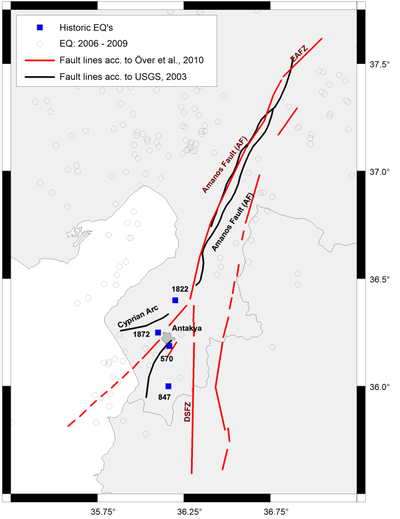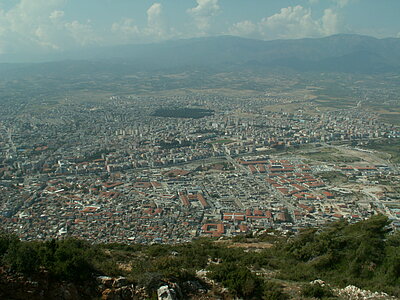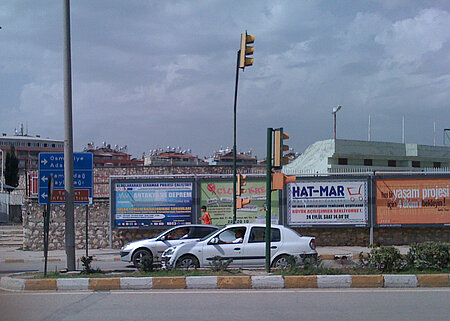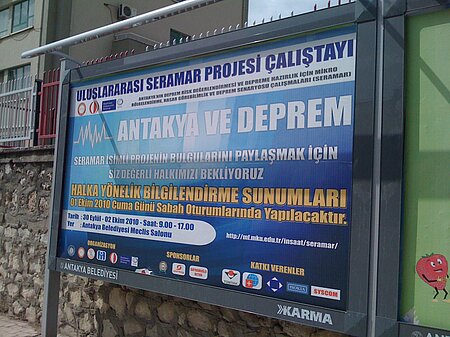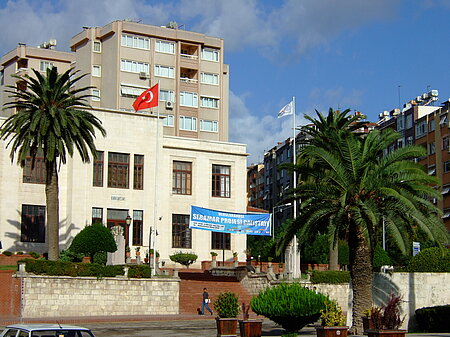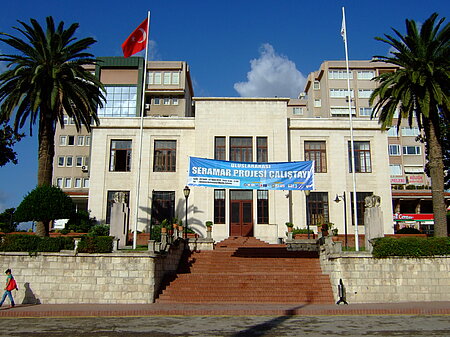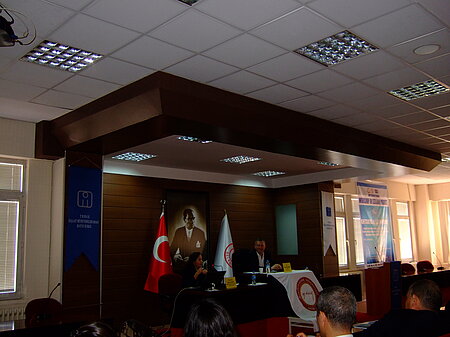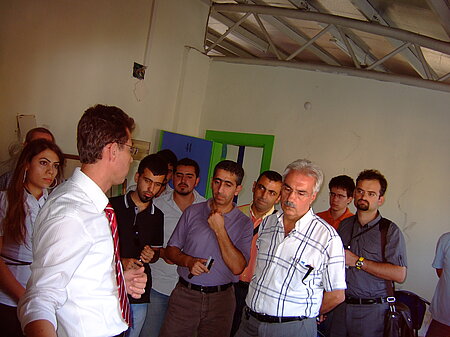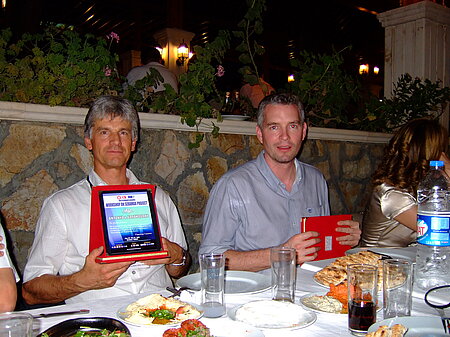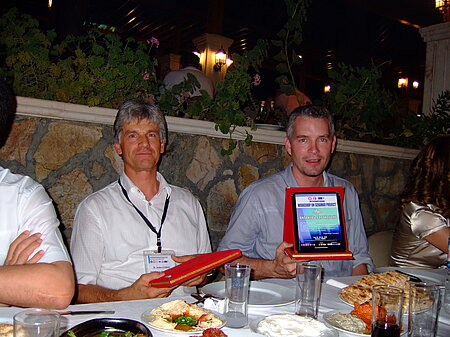Seismic Risk Assessment and Mitigation in the Antakya-Maras Region on the basis of Microzonation, Vulnerability and Preparedness Studies (SERAMAR)
SERAMAR stands for Seismic Risk Assessment and Mitigation in the Antakya -Maras Region on the Basis of Microzonation, Vulnerability and Preparedness Studies. The region straddles the area where the Dead Sea Fault Zone (DSFZ) blends into the East Anatolian Fault Zone (EAFZ), and is now an economically fast growing, increasingly more densely populated area that has been visited in its seismic past by many destructive earthquakes. The reduction of the risk in the urban centers is therefore of great importance for the cities that are exposed to the hazard.
The main objective of the SERAMAR project has been to utilize current tools for earthquake risk assessment in anticipation of the next damaging seismic event and to establish a unique partnership between universities, professional associations and local governments that might serve as a model for similar future activities in Turkey and other seismically susceptible areas of the world.
The steps might be encapsulated as:
- The thorough microzonation of an urban area being situated in a seismically exposed region of Turkey in the forefront of a damaging seismic event. This will need to be preceded by a complete documentation of the exposed building stock and its overall characteristics.
- The assessment of hazard, vulnerability, strategies and measures for risk mitigation, and improvement of preparedness.
- The protection and conservation of cultural heritage against earthquake-induced effects.
- Demonstration of the benefits of the study to local governments that will be involved in the studies.
Mustafa Kemal University Workshop on SERAMAR Project 2010

The workshop was held in the Conference Center of Antakya Municipality from September 30 to October 2, 2010. The workshop was organized by Mustafa Kemal University, Antakya, Bauhaus-Universitat Weimar, Germany and Middle East Technical University, Ankara. The goal of the workshop was to present the findings of the SERAMAR project to a wide audience and inform the local governments, the municipality, practitioners and citizens of this historic city about the seismic risk under which they live. The workshop was intended as a public outreach, but presentation of similar studies in other regions is encouraged.
The SERAMAR name is the abreviation of the title: Seismic Risk Assessment and Mitigation in the Antakya-Maras Region on the basis of Microzonation, Vulnerability and Preparedness Studies.
Topics Covered
Building stock properties for Antakya
- Geology and tectonics of the SERAMAR region
- Damage and seismic response prognosis for RC frame structures on the basis of hybrid approach combining instrumental and numerical data
- Identification of dynamic and seismic characteristics of regional predominant building types
- Calibrations of building models on the basis of experimental testing
- Recent developments in instrumentation techniques (sensors, topologies, recorders and exciters)
- Prediction of vulnerability functions of multistoried RC frame structures
- The scenario for Antakya on the basis of building vulnerabilities and postulated ground motions
Program
Detailed workshop program: download
Poster of the Project Partners
Further Developments and Activities
Proposals for Earthquake Master Plans in the Target Region of SERAMAR
The international discussions and attempts concerning seismic risk assessment, mitigation, and early warning especially in Turkey are mainly directed to the Marmara region around the mega city Istanbul. In contrast, it has to be seen that most of the harm and damage to be caused by earthquake disasters in Turkey occurred in small to middle-sized towns.
The main aim of the proposed project is the development of a master plan for mitigation and early warning especially concerning the earthquake risk for selected urban areas in the South-Anatolian Province Hatay which could become a model for other earthquake-prone regions in Turkey. Judging by historical precedence, major earthquakes on this branch of the Dead Sea-East Anatolian fault system establish a real potential to occur in most parts of this province.
The objective of this proposed study is to utilize current tools for earthquake risk mitigation within an environment where research entities from the European Research Area, local universities in Turkey and professional associations as well as local governments are enable to establish a unique partnership that would serve as a model for similar future endeavors.
Poster: Master Plan concerning Seismic Risk Assessment, Mitigation, and Early Warning in the Hatay Province on the basis of Microzonation, Vulnerability, and Preparedness Studies. Third International Conference on Early Warning, Bonn, March 27-29, 2006. download
Presentation: Earthquake Master Plan for Gaziantep City (2013). download
Bauhaus Summer School in Forecast Engineering: From Past Design to Future Decision 17-28 August 2015
Petrus, C., Maric, D., Thomaidis, I., Thomaidis, I.-P., Piombo, S., Scagliotti, G., Dimitrenko, E., Tirado, R. J., Kahsay Hagos, S., Abrahamczyk, L., Schwarz, J. (2015). Evaluation of Existing Masonry Structures under Multiple Extreme Impacts. In Band 32, Schriftenreihe des Instituts für Konstruktiven Ingenieurbau. Bauhaus-Universitätsverlag. download
Literatur
2006
Lang, D.H., Schwarz, J., Abrahamczyk, L., Langhammer, T., Geenen, E.M., Bikce, M., Kacin, S., Genes, M.C., Mazmanoglu, C., Gülkan, P., Tschurr, S. (2006):
Seismic risk assessment and mitigation in the Antakya-Maras region (Southern Turkey) on the basis of microzonation, vulnerability and preparedness studies (SERAMAR). International Disaster Reduction Conference, Davos, Switzerland, August 27 - September 1, 2006. download
Lang, D.H., Schwarz, J., Geenen, E.M., and the SERAMAR Working Group (2006):
Master Plan concerning Seismic Risk Assessment, Mitigation, and Early Warning in the Hatay Province on the basis of Microzonation, Vulnerability, and Preparedness Studies. EWC III - Third International Conference on Early Warning, Bonn, March 27-29, 2006. download
Schwarz, J., Lang, D.H., Abrahamczyk, L., Bolleter, W., Savary, C., Bikce, M., Genes, M.C., Kacin, S. (2006):
Seismic Building Monitoring of Multistory RC Structures in Turkey – A Contribution to the SERAMAR Project. First European Conference on Earthquake Engineering and Seismology (ECEES). Geneva, Switzerland, 3-8 September 2006, Stand-alone abstract and poster presentation. download
2007
Schwarz, J., Lang, D.H., Abrahamczyk, L., Bolleter, W., Bikce, M., Genes, C.M., Kacin, S. (2007):
Seismische Instrumentierung von mehrgeschossigen Stahlbetongebäuden – ein Beitrag zum SERAMAR Projekt. D-A-CH Tagung 2007, Wien, Tagungsberichte, Beitrag 23, 14 S. download
2008
Abrahamczyk, L., Schwarz, J., Lang, D.H., Leipold, M., Golbs, Ch., Genes, M.C., Bikçe, M., Kaçin, S. and Gülkan, P. (2008):
Building monitoring for seismic risk assessment (I): Instrumentation of RC frame structures as a part of the SERAMAR project. In Proceedings 14th World Conference on Earthquake Engineering, 12-17 October 2008, Abstract ID: 09-01-0140, Beijing, China. download
Genes, M.C., Bikçe, M., Kaçin, S., Akyuz, U., Gülkan, P., Abrahamczyk, L., Schwarz, J. (2008):
Building monitoring for seismic risk assessment (II): instrumental testing of RC frame structures and analytical reinterpretation of response characteristics. In Proceedings: 14th World Conference on Earthquake Engineering, 12-17 October 2008, Abstract ID: 09-01-0140, Beijing, China. download
Schwarz J., Langhammer T., Leipold M., Abrahamczyk L., Kaufmann Ch., Lang D.H., Riedel S. (2008):
Bewertung der Erdbebenverletzbarkeit eines Gebäudebestandes in innerstädtischen Großräumen – Phase 1 des SERAMAR Projektes. Bauingenieur 83 – D-A-CH Mitteilungsblatt, 2-10. download
2009
Abrahamczyk, L., Schwarz, J., Langhammer, T. (2009):
From instrumental building monitoring to vulnerability and risk assessment. In Proceedings Workshop on - Case studies of seismic building instrumentation and monitoring. Bauhaus-Universität Weimar
Genes, M.C., Bikçe, M., Kaçın, S., Akyuz, U., Gülkan, P., Schwarz, J., Lang, D.H., Abrahamczyk, L. (2009):
Identification of dynamic characteristics of multistory RC structures by combining instrumental and numerical data: case study Antakya, Turkey. In Proceedings: Earthquake & Tsunami 2009, Istanbul, Turkey.
Schwarz, J., Abrahamczyk, L., Langhammer, T., Leipold, M., Genes, M.C., Bikçe, M., Kaçin, S. (2009):
Building typology for risk assessment: case study Antakya (Hatay). In Proceedings Earthquake & Tsunami 2009, Istanbul, Turkey. download
2011
Abrahamczyk, L., Schwarz, J., Langhammer, T., Leipold, M. (2011):
Instrumentally based vulnerability studies of the building stock for the SERAMAR project. Proceedings of 63rd EERI Annual Meeting, February 9-12, 2011, San Diego, CA, USA. (Page 171)
2012
Abrahamczyk, L., Schwarz, J., Langhammer, T., Genes, M.C., Bikce, M., Kacin, S., Yakut, A, Erberik, A.M., Gülkan, P. (2012):
Empirical and Analytical Vulnerability Assessment of the Masonry Building Stock in Antakya (Hatay/ Turkey). 15thWorld Conference Earthquake Engineering, Lisboa 2012, Paper 1081. download
Genes, M.C , Erberik, A.M., Abrahamczyk, L., Gülkan, P., Bikce, M., Kacin, S., Yakut, A., Schwarz, J. (2012):
Vulnerability assessment of two instrumented masonry buildings in Antakya (Hatay, Turkey). 10th International Congress on Advances in Civil Engineering ACE2012 Middle East Technical University, Cultural and Convention Center, Ankara Turkey, 17-19 October 2012, Paper 1019. download
2013
Abrahamczyk, L. (2013):
Concepts for the seismic vulnerability assessment of a building stock: On the example of the SERAMAR project. Tashkent Institute of Architecture and Construction, (presentation).
Abrahamczyk, L., Schwarz, J., Langhammer, T., Genes, M.C., Bikce, M., Kacin, S. and Gülkan, P. (2013):
Seismic Risk Assessment and Mitigation in the Antakya-Maras Region (SERAMAR): Empirical Studies on the basis of EMS-98. Earthquake Spectra Vol. 29 (3), 683-704. doi.org/10.1193/1.4000163
Erberik, M.A., Yakut, A., Geneş, M.C., Abrahamczyk, L., Bikçe, M., Kaçın, S., Langhammer, T., Gülkan, P., Schwarz, J. (2013):
Characteristics of unreinforced masonry buildings in Antakya through field survey. 2nd Turkish Conference on Earthquake Engineering and Seismology - TDMSK, Sep. 25-27, 2013, Antakya, Hatay/Turkey, (Paper #120). download
Schwarz, J., Abrahamczyk, L., Gülkan, P. (2012):
SERAMAR – Seismic Risk Assessment and Mitigation in the Antakya-Maras Region on the basis of Microzonation, Vulnerability and Preparedness Studies. Special Session 25.1 “Findings of the SERAMAR Project” at the 15th World Conference on Earthquake Engineering, Lisboa, (presentation).
2014
Abrahamczyk, L.; Schwarz, J., Genes, M.C. (2014):
Qualification of seismic risk studies on the basis of instrumentally verified vulnerability functions for R.C. building types. In Proceedings: 10th U.S. National Conference on Earthquake Engineering, Anchorage Alaska, 21-25 July 2014. download
2015
Abrahamczyk, L., Langhammer, T., Schwarz, J. (2015):
Strategies for the vulnerability assessment of large building stocks. In: SECED 2015 Conference: Earthquake Risk and Engineering towards a Resilient World, 9-10 July 2015, Cambridge UK. download
Abrahamczyk, L., Schwarz, J., Genes, M.C. (2015):
Analytical Assessment of Existing Masonry Structures under EQ Loading by the use of ambient vibration measurements. 3rd Turkish Conference on Earthquake Engineering and Seismology (3.TDMSK), October 14-16, Izmir. download
Abrahamczyk, L., Schwarz, J., Langhammer, T. (2015):
Concepts for the seismic vulnerability assessment of a building stock: On the example of the SERAMAR project. Seminario "Desastres y Re-Construcción" Pontificia Universidad Catolica de Chile, Santiago de Chile, (presentation).
2017
Abrahamczyk, L., Langhammer, T, Schwarz, J. (2017):
Vulnerability assessment of large building stocks – Lessons from the SERAMAR project. In: 16th World Conference on Earthquake Engineering (WCEE), Santiago, Chile, 9-13 January 2017, Paper-No. 2046. download
2023
Schwarz, J., Abrahamczyk, L., Genes, C. (2023):
Erdbebenserie in der Grenzregion Türkei-Syrien: Fragen und erste Erkenntnisse. Bauingenieur 98, 4, Aufsatz im D-A-CH- Fachteil, 11–17. Download (8.6 MB)


